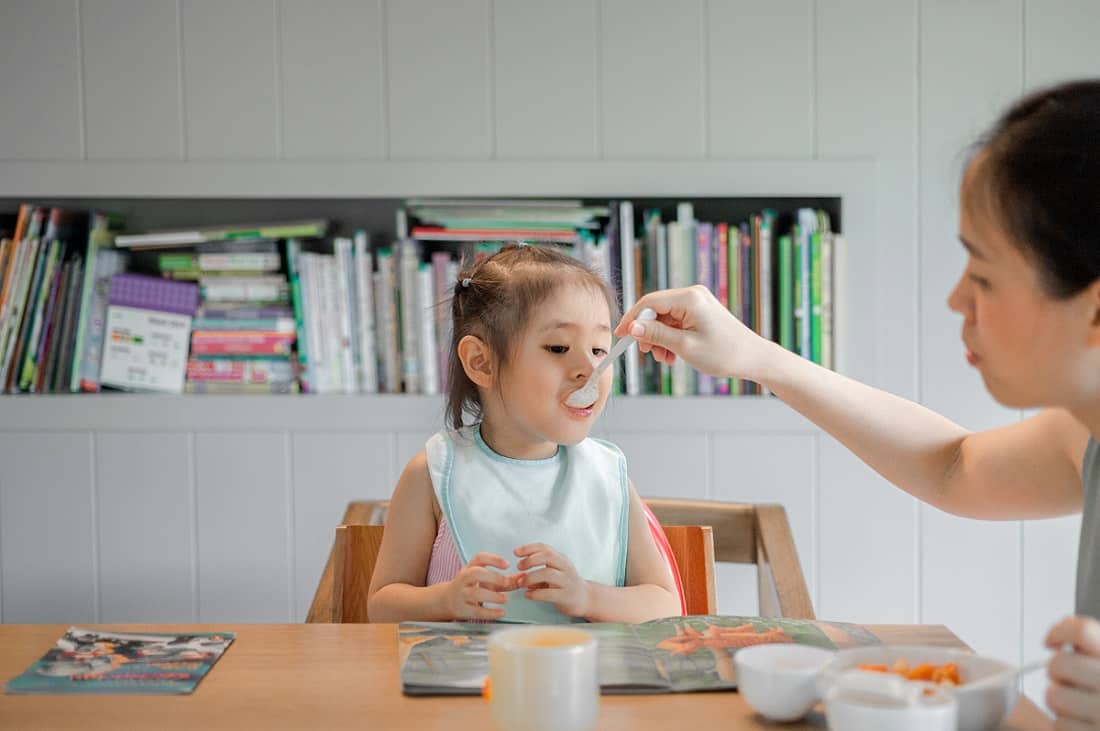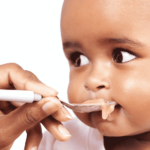When to Introduce Your Baby to Spoon

Introducing your toddler to spoon and fork is an important milestone. Between nine and fourteen months, most babies begin to show interest in using cutlery, mainly because they have watched you with keen interest as you used your spoon. But some toddlers do not pick interest in the use of cutlery, as they prefer the use of their fingers.
Some parents are asking, \”At what age should my child use cutlery?\” While some will say do not introduce spoon to your child before fourteen-month, I say otherwise. Introduce your child to cutlery as soon as your baby starts eating solids. And allow the child to try a spoon on his own as soon as he shows interest in using cutlery.
What developmental skill does introducing my baby bring?
When your baby begins to learn to feed himself, he is developing his fine motor skills. Every time your little one tries to take food into his mouth, and he either successfully gets it in or splashes it around his table and clothes, he is building his muscle strength and improving on his hand to mouth coordination aspect of his brain. This motor skill will grow stronger as your child grows, and it is this motor skill that will help him write legibly, brush his teeth and hair and carry out other activities that require a motor skill.
Don\’t shy away or delay your child from feeding himself because you are afraid of the mess. Mess helps them grow better and faster.
How to introduce your baby to spoon
The use of spoon in babies is an indicator of the development of fine motor skills. For a baby showing interest in using a spoon, you should start by introducing a spoon with meals like yogurt, oatmeal, pap, and some puree. Wear a bib around your baby\’s neck and be prepared for a messy mouth, hands, and apron. Hand the spoon to your baby and watch him scoop some quantity while you guide the spoon to his mouth because the probability that much of it will spill from the soon is high.
In this case of a child not picking interest in the use of a spoon, it becomes a conscious effort to help the child do so. You should come to the table with two spoons. Fill the spoon with the nutritious meal you have prepared for him and take it to his mouth. Then feed yourself; this is because babies learn by watching. Your child will watch you keenly and, after some time, will be willing to try taking their spoon into their mouth with little or no content.
Your baby is still likely not to master the use of spoon efficiently before eighteen months, but that is okay—no need to drill your child or beat yourself over that.
Another way is to use the hand over hand technique. You place your hand over your baby\’s hand and scoop some puree or yogurt into his spoon and lift it into his mouth. When you do this often with him, it will build his hand to mouth coordination.
When should you introduce fork to your baby?
Your baby doesn\’t necessarily need fork before fourteen months. Babies prefer using their fingers to feed themselves finger foods and any food that they can generally hold in their hands. But since you, as the mother, understands your baby more than anyone else, you should pay attention to his clues to see if he is ready to use a fork.
Some mothers have something to say about the introduction of the fork.
\”My baby started picking up my fork every time we ate spaghetti or noodles and wouldn\’t want to start with her hand, so I gave her a plastic fork designed for babies when she was eleven months.\” – Lauren
\”My son preferred using his fingers to eat finger foods. He didn\’t start using a fork until he was fifteen months.\” – Grace
What type of utensils should your baby be using?
I would not recommend using spoons and fork with metal or steel prongs and scoop before the age of three. A child can easily hurt himself either by poking themselves and their mouth with the metal prong and bowl of the spoon.
- A BPA-free plastic utensil is safe for a child.
- Get a soft and safe spoon and fork with round prongs.
- A silicone handle that is short, fat, and round to enable the baby to get a proper grip of the spoon or fork.
- Don\’t get any utensils with a super long handle for your baby to self-feed with.
- The tip should be one with a narrow bowl that will safely fit into the mouth.
- A spoon with a bowl too deep isn\’t suitable for a baby learning to use a spoon.
- A bump at the back of the handle to stabilize the eaten utensil when at rest.
Warning signs to look out for
Signs that your baby may not be suited for self-feeding yet either because he is at risk of poor oral structures or experiencing a delay in developing motor skills are:
- Your baby easily chokes on food or can\’t do without gagging
- He is experiencing difficulty with chewing and swallowing solid food.
In the case that you are beginning to introduce solids, you should pay attention to allergies that might arise and possible intolerance such as lactose intolerance. Sign such as
- Rashes
- Wheezing
- Hives
- Runny nose after feeding
- Swollen lips
- Discoloration in body
- Stuffy nose
- Swollen gum or tongue
- Vomiting
The possible presence of food allergy, and it becomes necessary to pay attention to ingredients or food that isn\’t going well with his body. Always wash and sterilize your baby\’s spoon and fork. Do not handle it carelessly.








